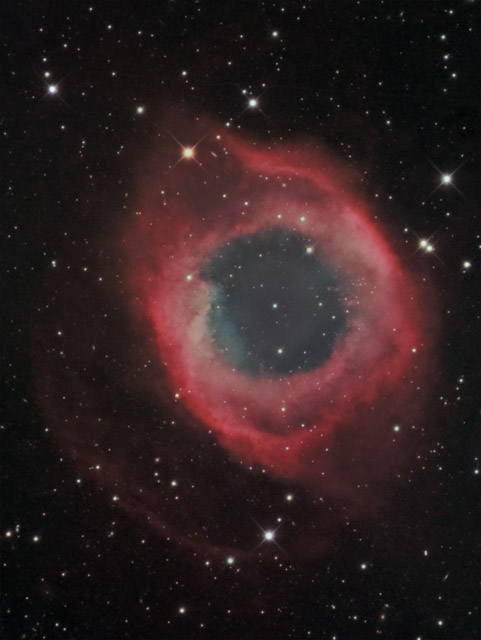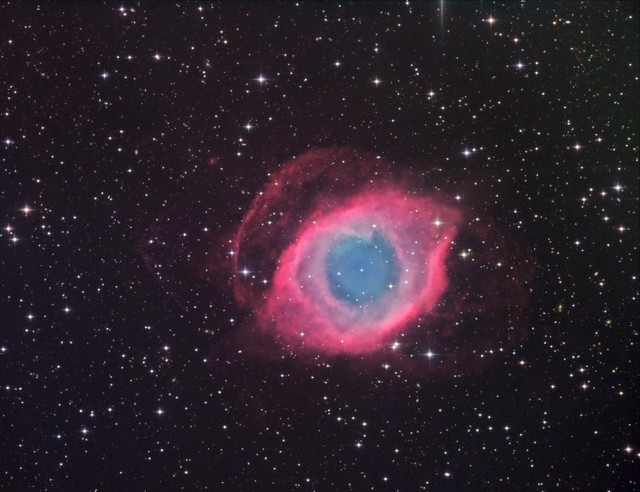| Time Travel Research Center © 2005 Cetin BAL - GSM:+90 05366063183 - Turkey / Denizli | |||
|
|
|||
|
NGC 7293
|
||
|
AQUARIUS - PLANETARY NEBULA - MAG 7.3 |
|||

NGC 7293 - THE HELIX NEBULA in AQUARIUS
|
About this Object: |
|
The largest planetary nebula in the night sky, the Helix Nebula, is some 10 times larger than the famous Ring Nebula (M57). While the Helix is no doubt of similar size to the Ring, it is much closer to Earth, perhaps some 450 light years away. So from our perspective, the Helix doesn't first remind us of a planetary nebula. Yet, everytihng else about it fits the mold of a planetary. It has a dying center star that is shedding its gases, it has heavy concentrations of oxygen about the center, and it glows with the typical ring of hydrogen surrounding the perimeter. The Helix, designated NGC 7293, shines at magnitude 7.3, though it can be a tough visual object for two reasons. One, its light is spread over a large surface area, making it low in contrast. And two, it's a southern object, resting at -20 in declination, so those in North America with undoubtedly deal with southern horizon issues. Even so, from a dark sky site, it's an easy target if you know what you are looking for. For the best view, lots of aperture will show a glorious view and the shape is unmistakable. But use too much power too early and you might skip over it entirely. Wider field views show the object well, appearing as a smudge even with binculars. The Helix,, despite the above, deserves attention. It's lovely indeed. |
Location:
Okie-Tex Star Party 2005
and Comanche Springs, 3RF dark sky site near Crowell, Texas
Date: October - November, 2005
Seeing:
2/10
Transparency: 6/10
Temperature: Chilly (-25 and -20 degrees C on camera)
Scope/Mount: 12.5" RCOS RC @ f/9 and Paramount ME
Camera: SBIG STL-11000M astro CCD camera
Exposure Info: LRGB image; 420:30:25:30 RGB (20 minute
subexposures for L, 5 minute subexposures for RGB, color binned)
Processing
Information:
Acquisition with CCDSoft.
Calibration (darks/flats), registration, gradient removal, and RGB channel
combine in CCDstack (median combine). LRGB combine, color balance, levels/curves,
and noise removal and local contrast enhancement (Noel Carboni's Astronomy
Tools) in Photoshop CS.
Exposure Notes: A difficult object because of the low southern views. Poor seeing, winds, and short RGB data set didn't help. Data taken across five different nights, none of which were spectacular. Interesting note, but this was 7 hours of clear luminance exposure, yet the image was still quite noisy and not very deep...if the data isn't good in quality, it'll likely have low S/N. Not a bad final result, but this one will require a return visit!

NGC 7293 : Helis Bulutsusu
Açıklama : Dünya'dan yalnızca yedi yüz ışıkyılı uzaklıkta, Kova
Takımyıldızı içerisinde yer alan güneş benzeri bir yıldız ölüyor. Bu
yıldızın son birkaç bin yılı, yıldız evriminin bu son evresinin tipik bir
örneği olan, yakınımızda yer alan ve iyice incelenmiş bulunan gezegenimsi
bulutsu Helis'i (NGC 7293) meydana getirmekle geçmiştir. Bulutsunun bu
dikkate değer ölçüde derinlikli görüntüsünü ortaya çıkarmak için neredeyse
11 saatlik poz süresi harcanmıştır. Görüntü, Helis'in yaklaşık 3 ışıkyılı
genişliğindeki parlak iç kısımlarının detaylarını olduğu kadar, ona yaklaşık
6 ışıkyıllık bir genişlik sağlayan dış halesinin soluk detaylarını da
göstermektedir. Helis'in merkezindeki beyaz nokta, bu gezegenimsi bulutsunun
sıcak, merkezi yıldızıdır. İlk bakışta basit görünümlü bir bulutsu olan
Helis'in, şaşırtıcı derecede karmaşık bir geometriye sahip olduğu daha yeni
anlaşılmaktadır.
Astronomi Nebula Resimler Astrophotography Galaxy Resimler Yıldız Resimler
Copyright(c) 2003 - 2005 - Cetinbal - All rights reserved.